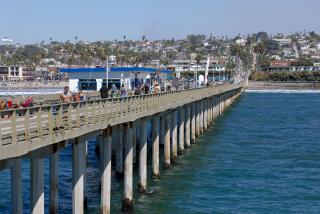Border wall could divert millions in critical funding from Naval Weapons Station Seal Beach
- Share via
President Trump’s plan to pull funding from military construction projects to pay for a wall along the U.S.-Mexico border could delay more than $139 million in critical infrastructure funding for U.S. Naval Weapons Station Seal Beach in Orange County, officials said.
The station’s needs include replacing a 60-year-old ammunition pier, dredging Anaheim Bay and constructing missile storage warehouses.
The installation’s strategic importance is expected to increase in coming years because the Navy plans to base 60% of its ships in the Pacific by 2020, up from 40% a decade ago, according to a Navy study.
Seal Beach’s primary missions are to store ordnance for the Navy and Marine Corps, load and unload ammunition and maintain weapons on warships departing San Diego.
At the request of Sen. Jack Reed (D- R.I.), the Joint Chiefs of Staff released a list of military construction projects this week that could be used as funding sources for the border wall. Seal Beach’s earmarked funding was listed as an eligible source.
Gregg Smith, public affairs officer for the weapons station, said the base’s construction funds had only been identified as a potential source of border wall funding.
“Especially knowing that, it would definitely not be appropriate for me to speculate on potential impacts to the base or the Navy at this time,” he said.
U.S. Rep. Harley Rouda (D-Laguna Beach), whose district includes Seal Beach, wrote in a statement that Trump chose to veto a congressional resolution terminating his border emergency, defying the consensus of both parties in the House and the Senate.
“I will not sit still and let the president raid hundreds of millions from California disaster relief funding, and put $139 million more in military construction projects for Seal Beach’s brave service members and their families on the chopping block,” Rouda wrote.
The replacement of the ammunition pier is considered vital by the Navy because the pier was built prior to modern earthquake standards, and a major seismic event could halt operations.
Dredging Anaheim Bay and reconfiguring the turning basin will allow Seal Beach to serve larger amphibious assault ships, which currently have to be resupplied at sea by Marine Corps helicopters off Camp Pendleton.
To allow vehicles to access the new wharf, the Navy will build a causeway across the east side of the bay and create an entirely new public navigation channel for Huntington Harbour.
The Navy currently closes Anaheim Bay to public boating traffic while ships are entering or leaving the base.
The new navigation channel will eliminate the need for such closures, which can last for about an hour and a half, said Paul De Graw, commodore of the Huntington Harbour Yacht Club.
“The yacht club was excited about the option that they came up with because it separates the harbor from the naval base,” De Graw said. “The members of the yacht club would be disappointed if the project didn’t go through.”
It’s unclear when the Trump administration would tap specific military construction projects for funding and how it long it would take to restore funding to those projects.
If the Navy decides to move ahead with funding Seal Beach on schedule, construction crews could break ground later this year or in 2020.
Langhorne writes for Times Community News
More to Read
Sign up for Essential California
The most important California stories and recommendations in your inbox every morning.
You may occasionally receive promotional content from the Los Angeles Times.













